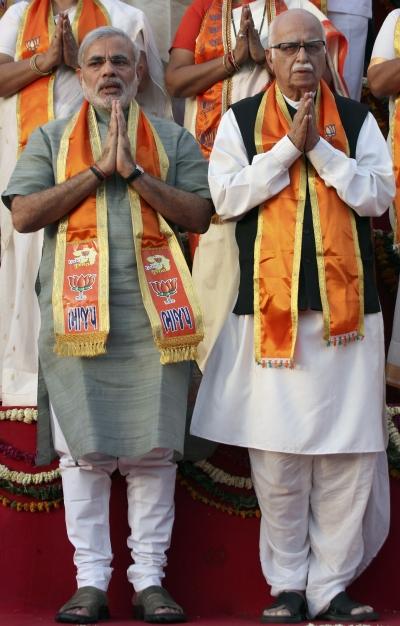
The differences between the two leaders underscore a major transition point in the political evolution of the saffron party
Recent developments in the Bharatiya Janata Party are not the result of either a simple power struggle within or a reflection of the internecine conflict within the Sangh Parivar. Lal Krishna Advani's unease is not just his own, though not everyone chose to publicly protest. Narendra Modi now towers above peers in the party not just because he has tremendous support from the cadre, but also from significant sections of the Sangh Parivar leadership.
Above everything else, the drama surrounding Modi's elevation and Advani's threatened exit has a significant ideological basis and underscores a major transition point in the political evolution of the BJP. If changes that have been effected are carried through, the BJP will go beyond the discourse of victimhood that it harped on from the days of the Ayodhya campaign.
Personal dislike of Modi's style of functioning and fear of marginalisation were not the only reasons many of his peers either dithered or actively blocked his elevation. These factors were combined with a huge amount of unspoken discomfort with the politics that Modi advocates. Since 2002, Modi has unabashedly pursued aggressive Hindutva and consciously evolved as the first mainstream political leader to completely break free of the Nehruvian mould of a political leader.
Despite emerging from a political lineage different from the Congress, previous BJP leaders -- including Atal Bihari Vajpayee and Advani -- stayed within the Nehruvian framework. At most, Advani pursued the Ayodhya agitation proactively but did not cross the Rubicon. In March this year, he contended that the BJP needed to make a "charter of commitments to minorities" in order to alter ties with them. In 2005, he made the infamous Jinnah statement because he felt that a "leader" in India must be placatory towards minorities and Pakistan was the right amphitheatre for such grandstanding.
...

Modi remains unapologetic about his political past and sees such symbolism as signs of weakness. Unlike Advani who gave photo-ops during his Ayodhya days with swords and other martial headgear but looked distinctly uncomfortable, Modi is naturally inclined to such devices.
He looks at home when brandishing weapons of offence and mouthing expletives -- describing relief camps as baby-producing factories being one instance. He is no longer selling victimhood -- this Sardar has already undone historical injustice and is now on the way to great development. Only those who either accept or come to terms with his discourse of 2002 can be beneficiaries of this development and growth.
It is not just his unease with democratic functioning and complete opposition to the Nehruvian secular framework, Modi also doesn't pay adequate emphasis to distribution in his growth model. In the so-called Gujarat model, there are large gaps in transfer of benefits to underprivileged sections because the model is loaded in favour of corporations. The concept of a welfare state is alien to him and many BJP leaders -- especially of the parliamentary hue -- are not in complete agreement with him that inclusive initiatives of the United Progressive Alliance can be rescinded with no electoral impact.
This is the reason for unvoiced reservations at the idea of Moditva, which projects only the aggressive face of Hindutva. In ways more than one, Modi represents both a solution for the BJP and the problem for it. For more than a year, Modi increasingly looked the only one capable of enthusing cadre and drawing support from outside the present vote bank of the BJP.
...

With the UPA in a tailspin, the clamour for a decisive leader has grown among urban middle classes in several parts of India -- in areas where the BJP has traditional support and even in newer regions. That such a leader is inherently totalitarian is beyond the pale of political understanding of neo-converts who otherwise cherish their personal freedom.
The polarising capacity of Modi is also not seen negatively by this section, already partially converted to the Hindutva fold in the course of the Ayodhya agitation and the Advani-led campaign against concepts like pseudo-secularism and appeasement. Modi, therefore, appears to be the BJP's best electoral mascot.
But then, Modi is also the problem. As the Advani episode demonstrated, Modi also polarises his own political fraternity. Regardless of how this episode is eventually resolved, it would damage Modi, even if marginally by demonstrating that uniting the party in his name remains difficult.
The Rashtriya Swayamsevak Sangh is also not the monolith of yore. For the moment, there are significant sections of the Nagpur leadership who pressured Rajnath Singh to appoint Modi. He has drawn strength from this group to have his way in struggles within the BJP. But there are also significant sections in the organisation who are opposed to him both personally and programmatically.
...

Within the Sangh Parivar there are groups that disagree with Modi's definition of Hindutva and his stance on religious minorities. Modi also will eventually face a problem reaching out to allies. He has close personal ties with leaders of some regional parties but so do others in the BJP, including Advani. Most regional chieftains run their parties in styles similar to Modi's and will find it difficult to work with a central leader who is not accommodative, like Vajpayee was.
If Modi chooses to alter his visage to forge unity in BJP and secure support of allies, he will lose his USP and risk alienation of his core supporters. A toned-down Modi will appear another version of other leaders, who are considered wishy-washy and not much of a popular draw. Modi faces few options, but to continue on the path of political polarisation. These are early days to predict whether such a strategy will take him closer to his goal. But with Modi's elevation, the BJP has decisively tilted to the right after being another version of the Congress.
...